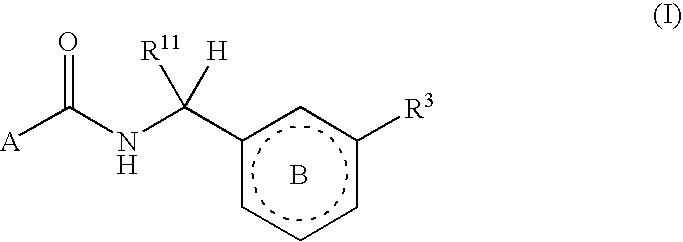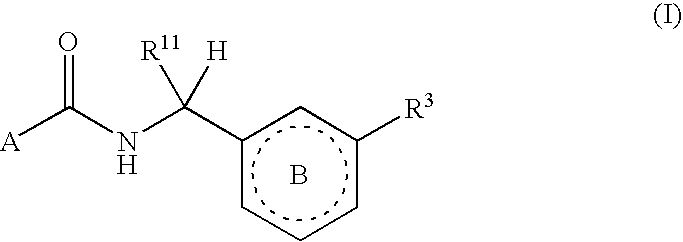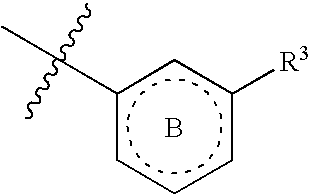Six-membered heterocycles useful as serine protease inhibitors
a serine protease inhibitor and six-membered heterocyclic technology, applied in the direction of biocide, drug composition, extracellular fluid disorder, etc., can solve the problems of ischemia and organ damag
- Summary
- Abstract
- Description
- Claims
- Application Information
AI Technical Summary
Benefits of technology
Problems solved by technology
Method used
Image
Examples
example 1
trans-4-Aminomethyl-cyclohexanecarboxylic acid[2-phenyl-1-(5-phenyl-pyridin-3-yl)-ethyl]-amide, bis-trifluoroacetic acid salt
[0338]1A. 5-Phenyl-pyridine-3-carbaldehyde: A biphasic mixture of 5-bromo-3-formyl pyridine (0.500 g, 2.69 mmol), Pd(Ph3P)4 (0.155 g, 0.134 mmol), and phenyl boronic acid (0.492 g, 4.03 mmol) in degassed 2.0 M aqueous Na2CO3 (6.0 mL) and toluene (6.7 mL) was heated at reflux for 2.5 h. The reaction was cooled to rt, diluted with water and EtOAc. The layers were separated and the aqueous layer was extracted with EtOAc (1×). The combined organic layers were washed with brine, dried over Na2SO4, filtered, and concentrated to give an orange-brown oil weighing 0.848 g. Column chromatography on silica gel gave 0.447 g (91%) of the biaryl compound as a pale yellow solid. 1H NMR (500 MHz, CDCl3) δ: 10.19 (s, 1H), 9.07 (s, 1H), 9.04 (s, 1H), 8.34 (s, 1H), 7.62 (d, J=7.7 Hz, 2H), 7.52 (t, J=7.7 Hz, 2H), 7.47-7.44 (m, 1H). MS 184.2 (M+H)+; 216.2 (M+CH3OH+H)+.
[0339]1B. 2-...
example 2
trans-4-Aminomethyl-cyclohexanecarboxylic acid[1-(1-oxy-5-phenyl-pyridin-3-yl)-2-phenyl-ethyl]-amide, bis-trifluoroacetic acid salt
[0342]To a suspension of 1C (0.062 g, 0.121 mmol) in dichloromethane (1.2 mL) was added m-chloroperbenzoic acid (0.042 g, 0.181 mmol). The resulting solution was stirred at rt for 2 h. The reaction was diluted with CH2Cl2 and washed with sat. sodium sulfite, sat. NaHCO3, brine, dried over MgSO4, filtered and concentrated to give a yellow solid (0.062 g). This solid was dissolved in 30% TFA in CH2Cl2 (5 mL). After 30 min, the reaction was concentrated. Prep. HPLC yielded, after lyophilization from CH3CN / H2O, 0.0371 g (56%, white solid) of Example 2 as the TFA salt. 1H NMR (500 MHz, CD3OD) δ: 8.50 (s, 1H), 8.26 (s, 1H), 7.75 (s, 1H), 7.61 (d, J=7.2 Hz, 2H), 7.53-7.47 (m, 3H), 7.30-7.27 (m, 2H), 7.24-7.20 (m, 3H), 5.26-5.23 (m, 1H), 3.19-3.10 (m, 2H), 2.76 (d, J=7.2 Hz, 2H), 2.23-2.18 (m, 1H), 1.86-1.79 (m, 3H), 1.69-1.67 (m, 1H), 1.60-1.53 (m, 1H), 1.44-1....
example 3
[trans-4-(5-{1-[(4-Aminomethyl-cyclohexanecarbonyl)-amino]-2-phenyl-ethyl}-pyridin-3-yl)-phenyl]-carbamic acid methyl ester, bis-trifluoroacetic acid salt
[0343]3A. 5-bromonicotinoylchloride: A suspension of 5-bromonicotinic acid (5.0 g, 24.8 mmol), thionyl chloride (5.4 mL, 74.2 mmol), and DMF (a few drops) in DCE (83 mL) was warmed to reflux. After 3 h, the reaction was cooled to rt and concentrated to give an off-white solid. The solid was dissolved in CH2Cl2 and concentrated. The process was repeated twice to give the acid chloride as an off-white solid.
[0344]3B. Benzylzinc chloride: To a cooled (0° C.), 0.5 M solution of ZnCl2 in THF (23.8 mL, 11.9 mmol) was added dropwise 2.0 M benzylmagnesium chloride (5.7 mL, 11.3 mmol) to give a milky-white suspension. After 30 min, the reaction was warmed to rt for 10-15 min and then used in the next step.
[0345]3C. 1-(5-Bromo-pyridin-3-yl)-2-phenyl-ethanone: To a cooled (−30° C.), solution of 3A (2.5 g, 11.3 mmol) in degassed THF (22.7 mL) ...
PUM
| Property | Measurement | Unit |
|---|---|---|
| temperature | aaaaa | aaaaa |
| temperature | aaaaa | aaaaa |
| enantiomeric excess | aaaaa | aaaaa |
Abstract
Description
Claims
Application Information
 Login to View More
Login to View More - R&D
- Intellectual Property
- Life Sciences
- Materials
- Tech Scout
- Unparalleled Data Quality
- Higher Quality Content
- 60% Fewer Hallucinations
Browse by: Latest US Patents, China's latest patents, Technical Efficacy Thesaurus, Application Domain, Technology Topic, Popular Technical Reports.
© 2025 PatSnap. All rights reserved.Legal|Privacy policy|Modern Slavery Act Transparency Statement|Sitemap|About US| Contact US: help@patsnap.com



